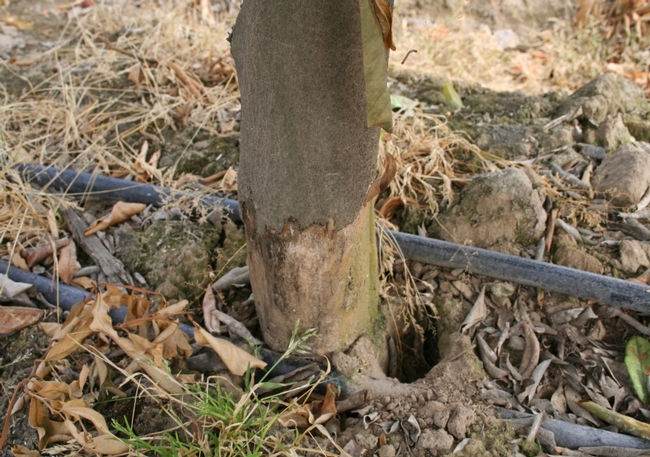Managing Wildlife in the Orchard
Discouraging pests and coexisting with beneficials

Snakes
Although they are often disliked, snakes are not a pest and do not cause damage on the farm. In fact, snakes provide valuable rodent control and require nothing in return save for respect and personal space. Gophersnakes will actively seek out rodent burrows to eat the inhabitants, and Rubber Boas like to eat baby mice, and can consume an entire litter in one meal. Rattlesnakes are the only snake in the area big enough to consume some of the larger invasive Black Rats and although rattlesnakes are venomous, they are very shy and do not seek to bite humans.
Snakes in the vineyard can and should be left alone to continue on their way, unless there is risk of harm to them (e.g. mowing) or they are affecting farm operations (e.g. rattlesnake in an irrigation box or toolshed). Killing snakes just because they show up in the orchard is not only completely unnecessary, it is also highly illegal under the BC Wildlife Act and comes with high financial penalty.

To reduce the chance of human-snake conflict in high-traffic areas:
-
Fill exterior holes in buildings with boards, steel wool or caulking. If you think a mouse can fit, it’s likely a snake can too.
-
Close in decks and stairs. Use skirting so that snakes cannot access storage areas under decks and stairs where they feel safe.
-
In high traffic areas, ensure there are no messy wood, rock, or debris piles that can serve as basking and retreat sites for snakes. This is also recommended for rodents (who are snake attractants).
-
Keep storage areas tidy and well lit.
-
Ensure crews are aware of Snake Smart practices such as wearing pants and boots in potential snake areas, looking underneath and around objects before moving them, and avoiding putting hands or feet in places they cannot see (e.g. under a pallet, stepping over large logs)

Okanagan Similkameen Stewardship offers free or low-cost Snake Smart workshops to local farms and farm crews.
These workshops involve snake identification tips, how to manage for snakes on the farm, and how to safely move a snake if absolutely necessary. For more information, send us a message.

Bears
Bears have an incredible sense of smell and can locate food over one kilometre away. Balck Bears are the only bear in the Okanagan and Similkameen, though they come in colours from light tan to black. They are omnivorous and eat anything from meat to seeds to fruit to garbage. The most effective way to keep bears out of an area is fencing, ideally electric fencing, but it is also important to manage any attractants aside from the fruit on the trees:
-
Do not allow windfall to accumulate on the ground. This also helps prevent rats.
-
Store smelly garbage inside or in secure bearproof containers
-
If honeybees are brought in for pollination, install temporary electric fencing around the hives.
-
Noisemakers can be a temporary solution in the fall, however bears may get habituated.

Invasive Birds
Bird control in agricultural settings is an entire industry. A multitude of options exists to try and reduce bird damage in the orchard, all of which have pros and cons.
It can be difficult to control fruit eating birds in the orchard while still allowing for helpful insect-eating ones, as popular noisemaking and visual scare devices will scare all birds and not just pests.

Netting is the most effective and least harmful option for limiting fruit damage while also allowing for other beneficial wildlife, but it can also be quite expensive. For more on wildlife friendly netting, check out the Netting page.
Sparrows and Starlings can be discouraged from nesting in the orchard by ensuring there are no suitable nesting cavities. Patch any holes in buildings that are 1.5" or larger and install vent covers if needed.
Note: Do not modify natural areas to remove nesting habitat. The overall benefits gained from the natural area is greater than the slight negatives from possible pest bird nests.
Rodents
Managing rodent damage to trees and general rodent presence require different approaches, but in both cases, rodenticides (rat poisons) should be avoided at all costs due to high potential for secondary poisoning.
-
Remove brush piles, and other woody debris that provides cover to discourage voles from migrating into the orchards.
-
Remove vegetation at the base of trees to discourage voles. Using mulch to supress weeds can reduce the need for herbicide.
-
Place wire or plastic mouse guards around the base of trees, especially young trees, to exclude voles. Vole guards should extend to at least 45 cm above soil level and 5-10 cm (2-4") below.
-
Traps: Use snap traps, humane compressed-air traps, or live traps. Never use sticky, glue or tar traps.


If rodenticides are needed as an absolute last resort, it is vital that only first generation poisons are chosen for use. Second-generation poisons are lethal at much smaller doses and can cause far more harm to predators up the food chain. There are also non-toxic rodenticides on the market that use dehydration to kill rodents and do not affect larger animals. Alternatively, poison can be placed in live traps so the poisoned animal cannot be eaten by another.
Rodent management can be improved by implementing Integrated Pest Management practices and attracting rodent predators to the orchard.
Further Reading
The following resources are information-only. Find the Financial Assistance page here
Wildsafe BC program website:
Okanagan Similkameen Stewardship Snake Smart Webinar Series (print resources also available in French, Spanish, and Punjabi)
https://www.osstewardship.ca/snakevideos
BC Grapegrowers Association Starling Control Program
https://www.grapegrowers.bc.ca/starling-control-program
University of Minnesota: Comparing Bird Management Tactics for Vineyards and Berry Crops
https://conservancy.umn.edu/bitstream/handle/11299/219068/bird-control-fact-sheet-2-2021.pdf?sequence=1
Bear Safety Tips for Livestock, Bees, Crops, & Orchards
https://bearwise.org/bear-safety-tips/livestock-crops/
Electric Fencing for Farms
https://www2.gov.bc.ca/assets/gov/farming-natural-resources-and-industry/agriculture-and-seafood/farm-management/structures-and-mechanization/300-series/307250-1_crop_protection_and_wildlife_control_fences.pdf
BC Ministry of Environment: The Rules [on rodenticides] Have Changed- A Guide for Agricultural Operators
Audobon Magazine:Poisons Used to Kill Rodents Have Safer Alternatives
https://www.audubon.org/magazine/january-february-2013/poisons-used-kill-rodents-have-safer
